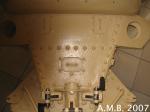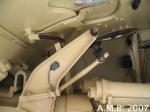Jagdpanther Mitte Londres
English Translation
 |
Historique Voir ICI
History Click HERE
Ce char est le Jagpanther du Major Erich Sattler du 3, 3e Régiment, Schwere Panzerjager Heeres Abteilung 559, qui a été détruit près de Hechtel,en Belgique
.. Ce véhicule est équipé comme un Panzerbefehlswagen (char de commandement) avec une radio supplémentaire.Dans le Mouvement de traite des forces allemandes la XVe Armée se retraite en Belgique et en Hollande devant l'avance des Alliés en Août 1944,
Hechtel est devenu une position défensive importante car elle se trouve à l'intersection de deux principaux axes routiers.
Le 1er Bataillon du Régiment Hermann Goering et le 10e Regiment parachutiste de Gramsel ont été envoyés de Cologne à Roermond aux Pays-Bas e d'ou il se deplace vers Hechtel à 50 kms pour s'y retrancher.
Les Fallschirmjager y exécutent 22 Belges (11 hommes et 11 femmes et enfants) comme partisans, mais il est probable que ces malheureses victimes se cachaient tout simplement dans leurs caves. En appui on trouve le 3e régiment de l'Abteilung schwere Heeres panzerjager 559, commandé par le Major Erich Sattler, avec sept Panzerjägers et trois Jagdpanthers,
. Le 8 Septembre 1944, les Welsh Guards, appuyé par le lieutenant W. Griffiths Hugh commandant un char Cromwell, attaquent et engagent les forces de Sattler.
Griffiths laisse passer le Jagpanther de Sattler et le Titeur Griffith loge quatre obus à l'arrière du Jagdpanther dans le moteur . Le cromwel a été manquée à deux reprises par les autres Jagdpanther . Au total 3 chasseurs de chars allemands furent détruits par les Welsh Guards. Sattler rendu inconscient évacue le Jagdpanther et retourne dans les lignes allemandes. La Guards Armoured Division,avec les Welsh Guards, attaque Hechtel encerclée le 10 Septembre. Le 12 Septembre, l'artillerie alliée lourde pillone la villes et contraint les Allemands à se rendre. 150 Allemands ont été tués, 220 blessés, et 500 capturés. 92 soldats britanniques ont été tués.
Major Erich Sattler's knocked-out Panzerjager (tank destroyer) V Jagdpanther SdKfz 173, 3rd Regiment, Schwere Panzerjager Heeres Abteilung 559, near the Hechtel, Belgium This vehicle is equipped as a Panzerbefehlswagen (command tank) with an extra radio. As the German 15th Army retreated into Belgium and Holland from the Allied advance in August 1944, Hechtel became a key defensive position, as it was at the intersection of two key main roads.
The 1st Battalion of the Hermann Goering Regiment and the 10th (Gramsel) Parachute Regiment were sent from Cologne to Roermond, Netherlands and then marched 50 kilometers (31 miles) to take up positions in Hechtel.
The fallschirmjager (paratroopers) executed 22 Belgians (11 men and 11 women and children) as partisans, but it is likely they were simply hiding in their basements. In addition, the 3rd Regiment of the schwere panzerjager heeres abteilung 559, commanded by Major Erich Sattler, with seven panzerjagers including at least three Jagdpanthers, were sent to prevent the Allies from gaining Hechtel
. On September 8, 1944, the Welsh Guards, including Lieutenant W. Hugh Griffiths commanding a Cromwell tank, was engaged by Sattler's forces. Griffiths allowed Sattler to pass and Griffith's gunner Sergeant Ivor Wilcox fired four rounds into the Jagdpanther's rear-mounted engine. Griffith's tank was missed twice by the other Jagdpanthers, but three of the German tank destroyers were destroyed by the Welsh Guards. Sattler was rendered unconscious while evacuating the Jagdpanther and after recovering his senses, evaded capture and returned to German lines. The Guards Armoured Division, including the Welsh Guards, attacked Hechtel and encircled the town on September 10. On September 12, Allied heavy artillery complled the Germans to surrender. 150 Germans were killed, 220 wounded, and 500 captured. 92 British troops were killed.
Autres Photoscopes (Others Walk Around ) 1 2
















.JPG)


